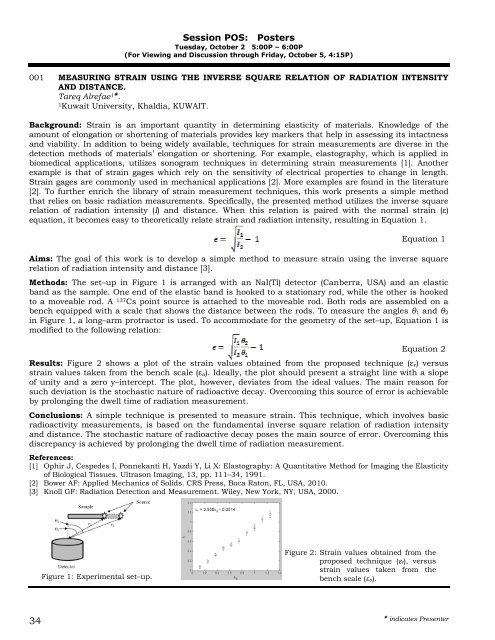2012 Proceedings - International Tissue Elasticity Conference
2012 Proceedings - International Tissue Elasticity Conference
2012 Proceedings - International Tissue Elasticity Conference
Create successful ePaper yourself
Turn your PDF publications into a flip-book with our unique Google optimized e-Paper software.
34<br />
Session POS: Posters<br />
Tuesday, October 2 5:00P – 6:00P<br />
(For Viewing and Discussion through Friday, October 5, 4:15P)<br />
001 MEASURING STRAIN USING THE INVERSE SQUARE RELATION OF RADIATION INTENSITY<br />
AND DISTANCE.<br />
Tareq Alrefae 1 .<br />
1 Kuwait University, Khaldia, KUWAIT.<br />
Background: Strain is an important quantity in determining elasticity of materials. Knowledge of the<br />
amount of elongation or shortening of materials provides key markers that help in assessing its intactness<br />
and viability. In addition to being widely available, techniques for strain measurements are diverse in the<br />
detection methods of materials’ elongation or shortening. For example, elastography, which is applied in<br />
biomedical applications, utilizes sonogram techniques in determining strain measurements [1]. Another<br />
example is that of strain gages which rely on the sensitivity of electrical properties to change in length.<br />
Strain gages are commonly used in mechanical applications [2]. More examples are found in the literature<br />
[2]. To further enrich the library of strain measurement techniques, this work presents a simple method<br />
that relies on basic radiation measurements. Specifically, the presented method utilizes the inverse square<br />
relation of radiation intensity (I) and distance. When this relation is paired with the normal strain (ε)<br />
equation, it becomes easy to theoretically relate strain and radiation intensity, resulting in Equation 1.<br />
Equation 1<br />
Aims: The goal of this work is to develop a simple method to measure strain using the inverse square<br />
relation of radiation intensity and distance [3].<br />
Methods: The set–up in Figure 1 is arranged with an NaI(Tl) detector (Canberra, USA) and an elastic<br />
band as the sample. One end of the elastic band is hooked to a stationary rod, while the other is hooked<br />
to a moveable rod. A 137 Cs point source is attached to the moveable rod. Both rods are assembled on a<br />
bench equipped with a scale that shows the distance between the rods. To measure the angles θ1 and θ2<br />
in Figure 1, a long–arm protractor is used. To accommodate for the geometry of the set–up, Equation 1 is<br />
modified to the following relation:<br />
Equation 2<br />
Results: Figure 2 shows a plot of the strain values obtained from the proposed technique (εr) versus<br />
strain values taken from the bench scale (εa). Ideally, the plot should present a straight line with a slope<br />
of unity and a zero y–intercept. The plot, however, deviates from the ideal values. The main reason for<br />
such deviation is the stochastic nature of radioactive decay. Overcoming this source of error is achievable<br />
by prolonging the dwell time of radiation measurement.<br />
Conclusions: A simple technique is presented to measure strain. This technique, which involves basic<br />
radioactivity measurements, is based on the fundamental inverse square relation of radiation intensity<br />
and distance. The stochastic nature of radioactive decay poses the main source of error. Overcoming this<br />
discrepancy is achieved by prolonging the dwell time of radiation measurement.<br />
References:<br />
[1] Ophir J, Cespedes I, Ponnekanti H, Yazdi Y, Li X: Elastography: A Quantitative Method for Imaging the <strong>Elasticity</strong><br />
of Biological <strong>Tissue</strong>s. Ultrason Imaging, 13, pp. 111–34, 1991.<br />
[2] Bower AF: Applied Mechanics of Solids. CRS Press, Boca Raton, FL, USA, 2010.<br />
[3] Knoll GF: Radiation Detection and Measurement. Wiley, New York, NY, USA, 2000.<br />
Figure 1: Experimental set–up.<br />
Figure 2: Strain values obtained from the<br />
proposed technique (εr), versus<br />
strain values taken from the<br />
bench scale (εa).<br />
indicates Presenter









